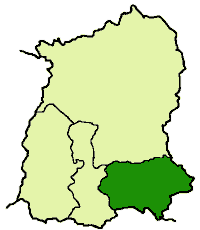East Sikkim
| East Sikkim | |
|---|---|
| District | |

The Teesta River flows for almost the entire length of Sikkim.
|
|
 East Sikkim's location in Sikkim |
|
| Coordinates: 27°19′N 88°36′E / 27.317°N 88.600°ECoordinates: 27°19′N 88°36′E / 27.317°N 88.600°E | |
| Country |
|
| State | Sikkim |
| Headquarters | Gangtok |
| Area | |
| • Total | 964 km2 (372 sq mi) |
| Elevation | 610 m (2,000 ft) |
| Population (2011) | |
| • Total | 281,293 |
| • Density | 290/km2 (760/sq mi) |
| Time zone | IST (UTC+05:30) |
| ISO 3166 code | IN-SK |
| Website | http://esikkim.gov.in |
East Sikkim is one of the four administrative districts of the Indian state of Sikkim. Geographically, East Sikkim occupies the south-east corner of the state. The capital of East Sikkim is Gangtok, which is also the state capital. It is the hub of all administrative activity in the state.
The civilian region is administered by a district collector, appointed by the Union Government and the military area by a Major General. As of 2011 it is the most populous of the four districts of Sikkim.
East Sikkim was part of the kingdom of Sikkim for most of its history. In the 19th century, the district was under the rule of the Bhutanese. After the Anglo Bhutan War, the territory was virtually under the command of the British forces. After India's independence in 1947, the area was part of the kingdom of Sikkim under the protection of India. During the Sino-Indian War of 1962, the Nathula Pass witnessed a few skirmishes between India and China. In 1975, the Sikkim formally became part of the Indian Union as India's 22nd state.The district was under the occupation of the Nepalese for 30 years in the eighteenth and nineteenth centuries.
The district occupies an area of 964 km².
Military-wise, the district is a very sensitive area with the Indian army having control over most areas east of Gangtok and near its borders with People's Republic of China and Bhutan. Visitors to this region are restricted and just a few areas are open to tourists in the areas east of Gangtok. Popular tourist locales are the Tsongmo Lake, Baba Mandir and the Nathu La pass. The pass formed the offshoot of the ancient Silk Road which connected Lhasa to India. The pass and Baba Mandir are open to Indian nationals only. To enter this region a special permit is required; the Inner Line Permit has to be obtained one day prior to departure. This permit is made through local tourist offices. Other tourist areas include the town of Gangtok, the Phodong Monastery north of Gangtok and the Rumtek Monastery.
...
Wikipedia
